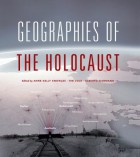Geographies of the Holocaust edited by Anne Kelly Knowles, Tim Cole, and Alberto Giordano
D 804.348 .G46 2014
“This book explores the geographies of the Holocaust at every scale of human experience, from the European continent to the experiences of individual human bodies. Built on six innovative case studies, it brings together historians and geographers to interrogate the places and spaces of the genocide. The cases encompass the landscapes of particular places (the killing zones in the East, deportations from sites in Italy, the camps of Auschwitz, the ghettos of Budapest) and the intimate spaces of bodies on evacuation marches. Geographic information systems (GIS) and cartography, as well as fieldwork and spatial ideation (the graphic expression of spatial ideas in diagrams and graphic art), provide the means for identifying, measuring, and comparing the spatial characteristics of historical sites, actors, relationships, and how they changed over time. Employing these techniques, backed by extensive historical research, the book aims to model the physical reality in which victims, perpetrators, and bystanders operated in order to ask new questions and to see historical circumstances in a new light.”
– publisher description

 The Flooded Earth: Our Future in a World Without Ice Caps
The Flooded Earth: Our Future in a World Without Ice Caps